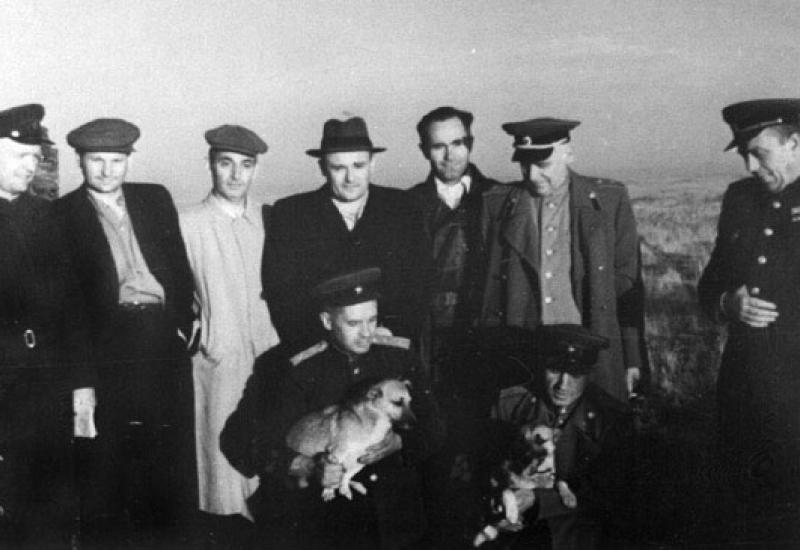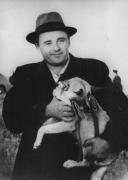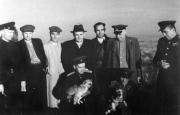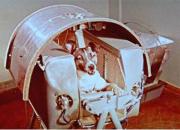In the late forties of the last century, the rocketry was intensively developing in the Soviet Union. The first domestically produced ballistic rocket P1 was launched on October 10, 1948 from the Kapustin Yar. It rose above 100 km, so it reached space heights, considering that the so-called Kármán line runs on the altitude of 100 km, which is the conventional border between Earth's atmosphere and outer space. Although, developing structures rockets and increasing their power just beginning, the designers have thought of human flying into space. As far back as 1946, a group of M.Tikhonravov and M.Chernyshova from NII-4 proposed first project of the stratospheric rocket BP-190 for vertical flight of two pilots to an altitude of 200 km. The project was approved by the Government and in 1948 it passed to implement in the CB Sergei Koroliov.
However, a man couldn't be sent into space, without having any idea of how complex factors, operating during flight comic, can affected on man, especially weightlessness. For this purpose, in NII of Aviation Medicine a program of research biomedical problems, which caused by flying on rockets was developed; A.Blahonravov, S.Koroliov and V.Yazdovsky led a preparation and realization.
Previously researchers planned to do this experiment on monkeys and dogs. However, it turns out that monkeys do not fit, because they are too whimsical, it is troublesome to train them, they have a restless behavior, and all these factors prevent prepare them for flight.
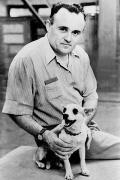 The dog it is a different matter, especially mutts. They quickly get used to humans and obey them. Moreover, underbred dogs are naturally have strong health, they are smart, well adapted to stress, unpretentious to food and they quickly learn what is required of them. That’s why researchers decided to use little dogs, weighing 5.6 kg. Dogs were chosen by considering a temper: they didn't take wild, gloomy and aggressive dogs. In addition, the advantage provided by a dog with a light color of hair, because they look better in photos and television.
The dog it is a different matter, especially mutts. They quickly get used to humans and obey them. Moreover, underbred dogs are naturally have strong health, they are smart, well adapted to stress, unpretentious to food and they quickly learn what is required of them. That’s why researchers decided to use little dogs, weighing 5.6 kg. Dogs were chosen by considering a temper: they didn't take wild, gloomy and aggressive dogs. In addition, the advantage provided by a dog with a light color of hair, because they look better in photos and television.
Of course, the experimenters could not know in advance, how flight will affect on animals. Therefore, researchers started to train elected mutts intensively. They were tested, as cosmonauts, on the centrifuge, in the aerospace chamber, on the flexible stand. Moreover, the animals were lying motionless for few days in the pressurized cabins. The selection was very thorough, but 14 four-footed future "cosmonauts" got training by the summer 1951.
The first task of the research was to study the possibility of survival dogs and other animals for flights to altitudes 110-200-470 kilometers. S.P. Koroliov is a primary missiles constructor, despite the fact that he was very busy to design new powerful combat missiles, he produced several geophysical missiles for testing and he very closely followed for the preparation and conduction experiments on animals.
Dezik and Tsygan were the first dogs to make an experimental flight on 22 July 1951. The rocket R1 blasted off at firing range Kapustin Yar. When it reached a height of 100 kilometers, compartment with dogs separated and began free falling. At an altitude of 7 km the parachute opened, and the container with "cosmonauts" landed safely. The flight was lasting about 20 minutes. Dezik and Tsygan took with overload and weightlessness, and they became the first in the history of humanity living creatures, that flight on ballistic missiles in the upper atmosphere to the conditional border with space.
According to witnesses, Koroliov was glad to this luck more than others. He caressed dogs, treating them with sausage, and then he put them in his car and drove "home" - in the crate, where they lived. Later academician Blagonravov took Tsygan, and dog lived in his cottage.
In a week, on July 29, the rocket blasted off at the second time. This time Dezik and Lisa flew. Dezik was sent a second time to see how he will behave during the second flight. Unfortunately, because of the barrel refusal, landing section parachute did not release at landing. Container with dogs at a high speed crashed into the ground. Dezik and Lisa died, becoming the first victims of space exploration programs. After this incident, S.Koroliov decided to design a system of emergency rescue for space flights.
During the tests there were also curious cases. September 3, 1951 missile launch P-1B was scheduled ,it was the end of the first phase of testing. Two dogs were prepared, including Smelaya, which had to fly again. In evening laboratory assistant took dogs out air dogs and took leashes down. Smelaya as if waiting for it, and she immediately ran to the steppe. Everyone searched for her, but she disappeared completely. It looks like the dog did not want to fly again. Then researchers took for flight any dog from those, who have always swirled around the dining room. Experimentators caught one nice dog, they washed it and attached sensors, the dog behaved quietly. The flight was good. After the flight Sergei Pavlovich went to the container's landing place and he immediately saw the substitution. Where did you get that? They had to tell him everything. Although, it was a contravention of the program, but they accidentally discovered, that dog can be sent into space without special training. Nameless dog was named "ZyB" - "Replacement of disappeared Bobik." In subsequent flights he did not take part - and Blagonravov took him.
In the summer of 1954, as Koroliov planned, a new stage of testing began, it was called testing emergency evacuation system in the active site of a flight or during landing. In this case, were planned to return the crew to Earth not in a special compartment, but in the individual suit.
Rigik and Lisa-2 were the first who made such flight on July 26, 1954. The catapult pushed Lisa in the spacesuit with the parachute at an altitude of 90 km and Rigik continued to fall to a height of 45 km, and only then catapult was activated. In both cases parachutes deployed at an altitude of seven kilometers. Both dogs underwent emergency landing perfectly. Thus began the emergency evacuation's creation of cosmonauts.
1956 year was the beginning of the next phase of testing research connected to the cabin and special support system, in which an animal could live up to 30 days. By this time the dogs are raised to a height of 450 km. They take well with noise, vibration, overload, weightlessness. It was the time, when it was necessary to make a long orbital flight around the Earth with animals. To do this, the powerful launch vehicles had to apply, which were tested and launched at the Baikonur Cosmodrome.
On October 4, 1957 the first artificial Earth satellite was launched. Launched satellite with a dog not planned any time soon, because system of returning from orbit was not yet ready.
But the Soviet guidance wished to launch a dog into orbit as soon as possible, by the 40th anniversary of the October Revolution, celebrated on November 7, 1957. It was not enough time to prepare such an important project, but Koroliov agreed to implement it.
Three challengers: Albina, Laika and Muha were ready for space flight on the satellite №2 . Albina was selected the first. But she had puppies, so researchers regretted her. Muha tested the life support system on the Earth, scientists decided that it is enough for her. Laika was the last. The test engineers knew that the dog will not return to the Earth, because there was not lander. It was planned that it can live for about a week in the space, and then in order to save her from suffering, they made her a somnolent injection.
Launch was delayed by nearly three days, for technical reasons. All this time the rocket with the satellite stood at the start, with Laika inside. Of course, this had negative consequences for the dog. Finally, the launch was on November 3, 1957.
The satellite's flight with the dog on board played a huge propaganda value. A couple of days USSR newspapers regularly informed about Laika's health. Readers believed that she would return to Earth. Only five years later the true information was published: satellite was on the wild trajectory, in other words, on the highly-elliptical orbit with an apogee of 947 km. Every revolution led to a significant heating of spacecraft by solar radiation, as a resalt the temperature in the cabin after the first revolutions exceeded the permissible limits. In a 5-7 hours after the start Laika was already dead. But for the world Laika remained as a symbol of the space age.
After Laika's launch, the orbital flights with dogs were not met for almost three years. Meanwhile, on the Kapustin Yar firing range, dogs with the help of the powerful missiles R-5A were raised to a height of 400 kilometers or more. October 31, 1958, Zhulka and Knopka reised to an altitude of 415 km. And Pistryanky and Bilyanky gained the record altitude about 473 km on Aug. 27, 1958. However, they felt overload from 7 to 24 g during the descent .
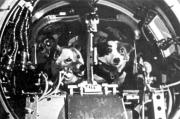 Testing high-altitude missiles helped to solve a number of difficult scientific problems and get important experimental data from testing of guidance, navigation, returning to Earth. However, many dogs flew into space several times, Horobriy made it five times.
Testing high-altitude missiles helped to solve a number of difficult scientific problems and get important experimental data from testing of guidance, navigation, returning to Earth. However, many dogs flew into space several times, Horobriy made it five times.
In October 1960 the Soviet government approved a secret decision, a human flight into space. Appointed term was December 1960. Flight readiness was necessary to confirm by two successful launches ships with dogs. Whereby the developers should sure in the life support system reliability, overload's allowability in different parts of the flight, functional capability and ensuring the return of staff and landing on Earth.
The first launch of the dogs, which were training for the program for human space flight took place on July 28, 1960. Unfortunately, the launch was safing - the side rocket block first degree fell during the active area of the flight. Dogs Chaika and Lisichka died in this crash. The Soviet press said nothing about this setback. They were waiting for positive results.
The first in the history of space being's orbital flight with returning to Earth took place on August 19, 1960. Two dogs Belka and Strelka were successful "cosmonauts", who made his flight on the spacecraft named "Sputnik-5". S.P. Korolyov was very pleased with the test results, but for full guarantee of success must be one more launch with positive results.
December 1, 1960 the launch of the third spacecraft was held, there were Bdgilka and Mushka on the board. But the flight ended in failure, because the ship occured on the wild trajectory during the descent and went outside the USSR, and heads were forced to cease ship's existence. Next launch on 22 December was also unsuccessful, though dogs thanks to an emergency landing were not injured.
Successful launches have taken place in March 1961. On March 9 Chornushka made a single-turn orbital flight on a new modification of the ship "Vostok-3".Chernushka was accompanied into space with a dummy cosmonaut named Ivan Ivanovich, which measured the overload in the active site of the flight, at the moment of bailout and during landing. The flight went off without a hitch, the equipment worked flawlessly. 25 March 1961 Zirochka made the same flight in a similar program, with a dummy cosmonaut. The flight and landing were normal.
These flights were the last control tests before the human flight into space. Medical scientists led by V.Yazdovsky and O.Hazenko received very important information about changes physiological functions and behavior of animals during the orbital flight. Zirochka was the last who opened the way for human-cosmonaut into space. By the way, Zirochka was originally named Luck. But someone (say it was Yuri Gagarin) asked: if it will a failure? And then the dog was called Zirochka.
In a two and a half week, after the Zirochka's flight, the man launched into space.
12 April 1961 the spacecraft "Vostok" were brought into orbit , which was carrying with a senior lieutenant Yuri Gagarin.
Thus, the true friends of man is a dog, who served man from ancient times, dogs were the man's guardians, dogs helped hunt and grazed cattle. In the twentieth century dogs helped man to open a space, a new era in human history. We can say, that dogs found out the way to space for a man.

